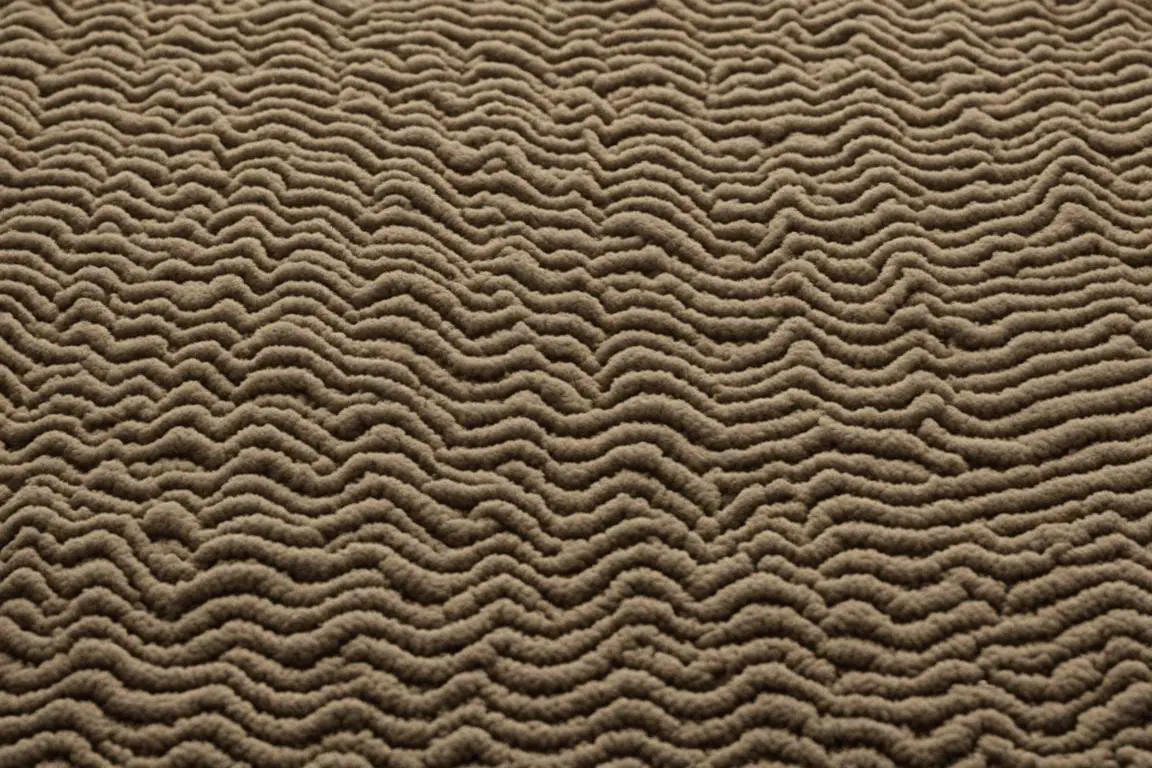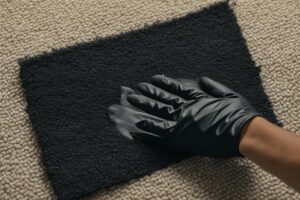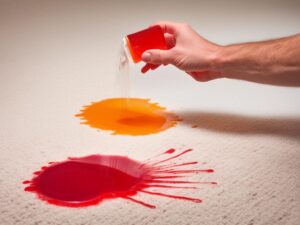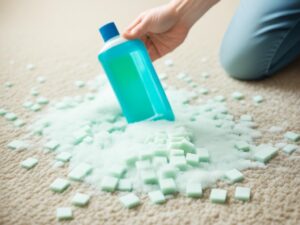If you’ve noticed waves or ripples in your carpet, you’re not alone. Carpet rippling, also known as carpet buckling, is a common issue that many homeowners face. These unsightly waves can make your floor look uneven and diminish the overall appearance of your space. But what causes a carpet to ripple in the first place? And more importantly, how can you fix it? In this article, we’ll explore the causes of carpet rippling and provide effective solutions to help you restore a smooth and flawless floor.
Key Takeaways:
- Prolonged exposure to moisture, poor product quality and installation, and improper maintenance can cause carpet rippling.
- Controlling indoor humidity levels and addressing water issues promptly can minimize the risk of carpet rippling.
- Choosing high-quality carpets, following manufacturer recommendations for padding, and professional installation are crucial for avoiding carpet rippling.
- Mild to moderate rippling can often be fixed through professional restretching, while regular maintenance can help prevent and minimize future rippling.
- By taking preventive measures and seeking timely remedies, you can enjoy a flawless and long-lasting carpet.
The Role of Moisture in Carpet Rippling
One of the main causes of carpet rippling is prolonged exposure to moisture. High humidity levels in the home can lead to carpet swelling and overstretching, resulting in ripples.
When the moisture content in the air is high, the carpet fibers absorb the excess moisture and expand. This causes the carpet to stretch beyond its normal dimensions, causing ripples to form. Over time, if the moisture problem is not addressed, the ripples can become more pronounced and permanent.
Additionally, water damage from floods or plumbing failures can cause the carpet to become wet and buckle. The excessive moisture weakens the carpet’s backing and adhesive, leading to rippling. It is crucial to address water issues promptly and ensure thorough drying to prevent further damage.
Even improper water-based cleaning methods can contribute to carpet rippling. If excess moisture is left in the carpet after cleaning, it can cause the carpet fibers to swell and create ripples. It is important to follow proper carpet cleaning techniques, such as using the right amount of water and ensuring adequate drying time, to avoid carpet rippling.
Excess moisture can be detrimental to the structural integrity of carpets, leading to unsightly ripples and potential permanent damage. Taking proactive measures to control indoor humidity levels, address water issues promptly, and follow proper carpet cleaning techniques can significantly reduce the risk of carpet rippling.
By understanding the role of moisture in carpet rippling and implementing preventive measures, homeowners can maintain their carpets in optimal condition and avoid the need for costly repairs or replacements.
Now that we’ve explored the impact of moisture, it’s important to consider the influence of product quality and installation techniques on carpet rippling. In the next section, we’ll delve into how these factors can contribute to this common issue.
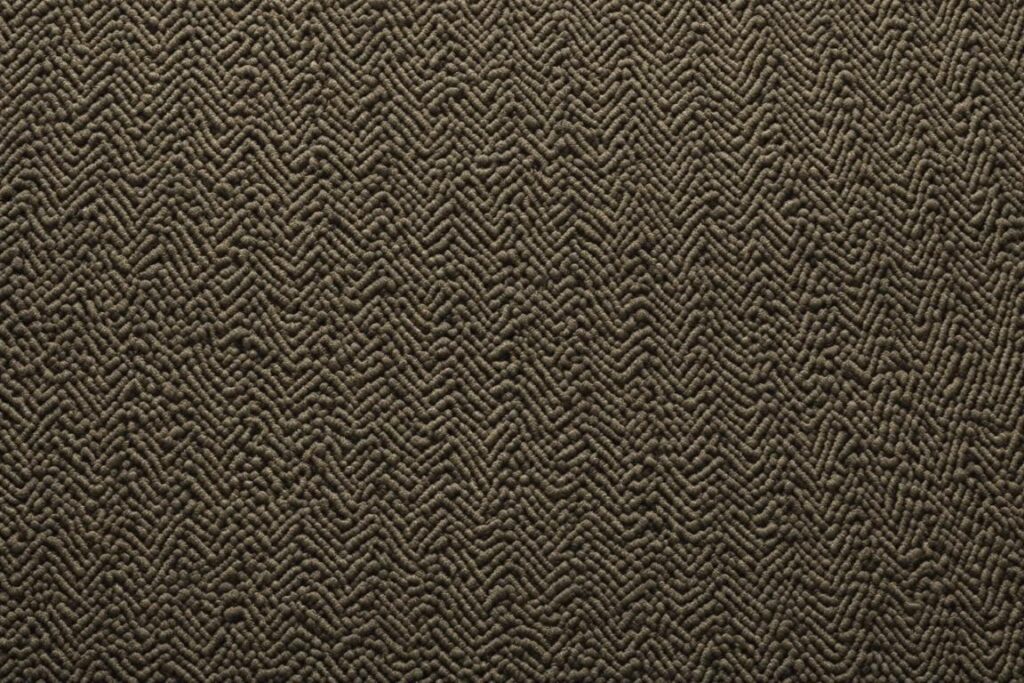
Product Quality and Installation Impact on Carpet Rippling
When it comes to carpet rippling, the quality of the product and the proper installation are crucial factors to consider. Cheap and low-quality carpets are more prone to buckling and developing ripples over time. To ensure a durable and ripple-free carpet, it is essential for homeowners to choose high-quality carpets that can withstand everyday wear and tear.
Moreover, the type of carpet padding used also plays a significant role in preventing carpet rippling. The right carpet padding provides stability and support, reducing the chances of the carpet becoming loose and developing ripples. It is recommended to follow the manufacturer’s recommendations for the appropriate type of padding to use with your chosen carpet.
However, no matter how high-quality your carpet and padding may be, improper installation techniques can still lead to carpet rippling. In fact, improper installation can even void the product’s warranty, leaving you with unexpected repair costs. To avoid such issues, it is crucial to have your carpet professionally installed by experts who use the correct tools and techniques.
Professional installation not only ensures that the carpet is properly stretched and secured but also helps maintain the carpet warranty. By following the manufacturer’s installation guidelines and working with experienced professionals, you can have peace of mind knowing that your carpet is installed correctly and any potential issues, like rippling, are minimized.
“Investing in high-quality carpets and following proper installation procedures are essential to prevent carpet rippling and maintain the longevity of your flooring.”
Remember, taking the time to choose a high-quality carpet, using the right padding, and investing in professional installation are all crucial steps in preventing carpet rippling and ensuring a long-lasting, visually appealing floor.
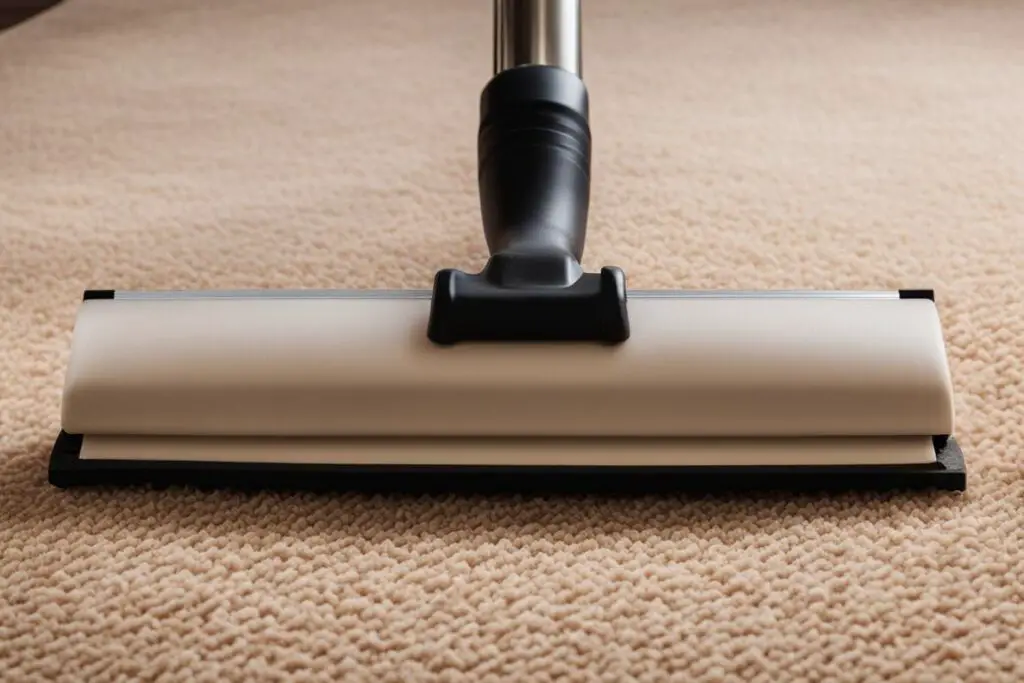
Comparison of Product Quality and Installation Impact on Carpet Rippling
| Factors | Low-Quality Products and Improper Installation | High-Quality Products and Professional Installation |
|---|---|---|
| Carpet Quality | More prone to buckling and rippling | Durable and less likely to develop ripples |
| Carpet Padding | Inadequate support, contributing to rippling | Providing stability and reducing the chance of rippling |
| Installation Techniques | Incorrect stretching, leading to rippling | Proper stretching, minimizing the risk of rippling |
| Warranty Coverage | Voided due to improper installation | Maintained with professional installation |
Maintaining and Repairing Rippled Carpets
When carpet rippling occurs, it is important to take action to address the issue. Mild to moderate rippling can often be fixed through professional restretching. This process involves using specialized tools to remove the wrinkles and tighten the carpet back to its original position. Hot-water extraction can also be used to further flatten the area where the ripples were. Regular carpet maintenance, including professional cleaning and mindful use, can help prevent and minimize carpet rippling.
Professional Restretching: Restoring the Flawless Look
For mild to moderate carpet rippling, professional restretching is an effective solution. Certified professionals utilize specialized tools to remove the wrinkles and creases, ensuring that the carpet is smoothed out and tightened back to its original position. This process not only resolves the rippling issue but also restores the flawless and well-maintained appearance of the carpet.
Hot-Water Extraction: Additional Flattening and Cleaning
In some cases, after restretching, there may still be residual unevenness or areas where ripples were more pronounced. Hot-water extraction, a common method used in professional cleaning, can further flatten the carpet and ensure a uniform surface. This process involves using hot water and a specialized cleaning solution to extract dirt, debris, and residue from the carpet fibers, leaving them clean and upright.
| Maintenance Tips | Benefits |
|---|---|
| Regular Vacuuming | Remove dust, dirt, and debris that can contribute to carpet rippling. |
| Spot Cleaning | Address spills and stains promptly to prevent moisture-related carpet rippling. |
| Professional Cleaning | Deep clean carpets to remove embedded dirt, debris, and allergens for optimal carpet maintenance. |
| Mindful Use | Avoid dragging heavy furniture and take precautions to prevent excessive wear and tear on the carpet. |
“Regular carpet maintenance, including professional cleaning and careful use, can go a long way in preventing and minimizing carpet rippling. By addressing minor rippling promptly through professional restretching and utilizing hot-water extraction, homeowners can maintain a beautiful and ripple-free carpet.”
By following these maintenance tips and addressing rippling issues promptly, homeowners can keep their carpets in excellent condition and extend their lifespan. Maintaining a well-cared-for carpet not only enhances the overall aesthetics of the room but also provides a comfortable and clean environment for the entire household.
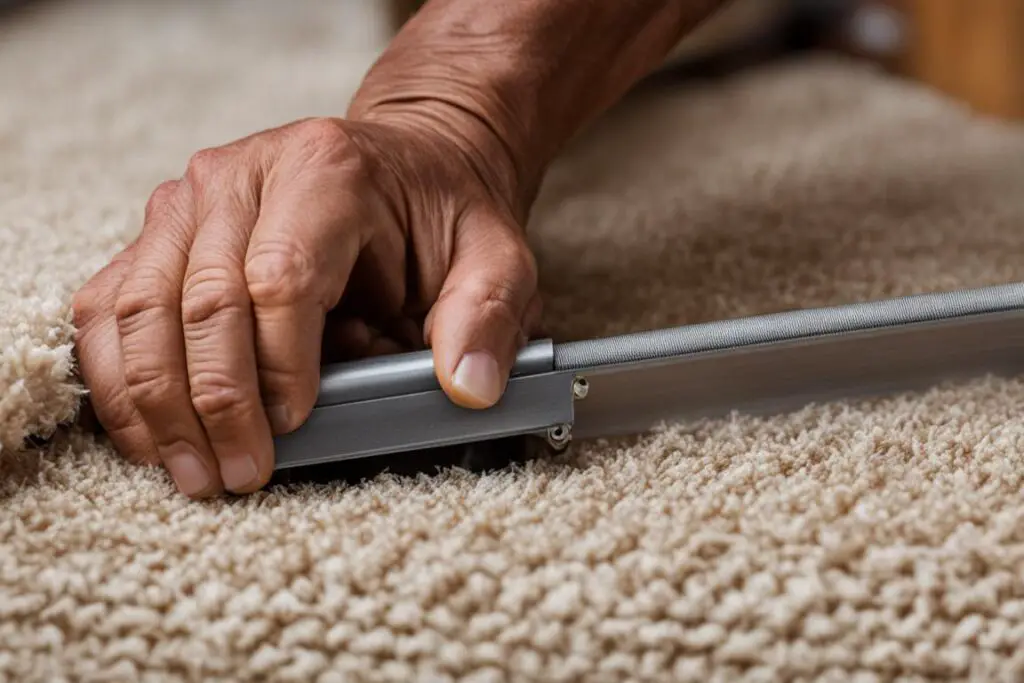
Effective Measures to Minimize Carpet Rippling
Proper maintenance and preventive measures can significantly reduce the occurrence of carpet rippling in homes. By taking the following steps, homeowners can ensure their carpets remain smooth and free of unsightly waves.
Controlling Moisture Levels
Moisture control is essential for preventing carpet rippling. Excess moisture can cause the carpet fibers to swell and stretch, leading to rippling. To control moisture levels:
- Use a dehumidifier to reduce humidity in the home, especially in areas prone to high moisture levels.
- Promptly address any spills or water damage by thoroughly drying the affected area.
- Avoid excessive use of water during carpet cleaning and ensure proper drying after cleaning.
By maintaining optimal moisture levels, homeowners can minimize the risk of carpet rippling caused by moisture-related issues.
Choosing Quality Carpets and Padding
The quality of the carpet and padding chosen plays a crucial role in preventing carpet rippling. High-quality carpets are less likely to buckle over time and offer better resistance to rippling. When selecting carpets and padding:
- Opt for carpets from reputable brands known for their quality and durability.
- Follow the manufacturer’s recommendations for the appropriate type and thickness of padding.
By investing in quality carpet materials, homeowners can reduce the risk of carpet rippling and ensure a longer lifespan for their carpets.
Professional Installation
Proper installation is key to preventing carpet rippling. Hiring a professional carpet installer who has the necessary skills and uses the correct tools can make a significant difference in avoiding rippling issues. When getting carpets installed:
- Choose a qualified and experienced carpet installer.
- Ensure that the installer follows manufacturer recommendations and industry best practices for installation.
By prioritizing professional installation, homeowners can minimize the chances of carpet rippling caused by improper installation techniques.
Regular Carpet Maintenance
Ongoing maintenance is essential for keeping carpets in optimal condition and preventing rippling. Consider the following carpet maintenance tips:
- Schedule regular professional carpet cleanings to remove dirt, dust, and debris that can contribute to rippling.
- Avoid dragging heavy furniture across the carpet, as it can stretch and loosen the fibers.
- Use furniture coasters or protective pads to distribute weight evenly and minimize the risk of rippling.
By staying proactive with maintenance, homeowners can minimize the occurrence of carpet rippling and extend the lifespan of their carpets.
Following these effective measures, including moisture control, choosing quality carpets, ensuring proper installation, and regular carpet maintenance, can significantly reduce the risk of carpet rippling. By understanding the factors that contribute to carpet rippling and taking the necessary precautions, homeowners can enjoy smooth and flawless carpets for years to come.
Common Causes of Carpet Rippling
Carpet rippling can be a frustrating problem for homeowners. Understanding the common causes of carpet rippling can help you prevent and address this issue effectively. Here are the main factors that contribute to carpet rippling:
- High Humidity: Excessive moisture absorption due to high humidity levels can cause the carpet to swell and create ripples. It is important to control indoor humidity to minimize the risk of carpet rippling.
- Heavy Furniture: Dragging heavy furniture across the carpet surface can stretch and loosen the carpet, resulting in ripples. Be cautious when moving furniture to avoid damaging your carpet.
- Improper Installation: Improper installation techniques, such as inadequate stretching or using incorrect tools, can lead to carpet rippling. Ensure that you hire professionals who follow proper installation practices.
- Carpet Delamination: In some cases, carpet delamination, where the layers of the carpet separate, can cause rippling. This can occur due to age, wear, or poor manufacturing quality.
Preventing Carpet Rippling
To prevent carpet rippling, it is essential to address these causes. Control indoor humidity levels, use furniture sliders when moving heavy items, ensure proper installation by qualified professionals, and regularly inspect your carpet for signs of delamination. Taking preventive measures can help you maintain a smooth and ripple-free carpet.
Addressing Carpet Rippling
If you already have rippled carpets, it is recommended to seek professional assistance for repairs. Professional carpet restretching can remove the wrinkles and tighten the carpet, restoring its original appearance. Prompt action can prevent further damage and ensure a long-lasting carpet.
Expert Tip:
Proper maintenance and regular professional cleaning can also contribute to minimizing carpet rippling. It is advisable to follow the manufacturer’s guidelines and seek professional cleaning services to keep your carpet in excellent condition.
Prevention and Remedies for Carpet Rippling
To maintain a ripple-free carpet, proactive prevention and timely remedies are essential. Preventing carpet rippling involves controlling indoor humidity levels, avoiding heavy furniture dragging, and ensuring proper installation. Regular maintenance, including professional cleanings and occasional stretching, can help preserve the carpet’s integrity and minimize rippling issues.
Controlling Indoor Humidity
To prevent moisture-related carpet rippling, it’s crucial to control indoor humidity levels. High humidity can cause the carpet fibers to absorb excess moisture and expand, resulting in ripples. Use a dehumidifier or air conditioning system to maintain optimal humidity levels in your home.
Avoiding Heavy Furniture Dragging
Dragguing heavy furniture across the carpet can stretch and loosen the surface, causing unsightly ripples. To avoid this, use furniture sliders or lift the furniture when moving it. Taking this simple precaution can protect your carpet and prevent rippling.
Ensuring Proper Installation
Proper carpet installation is vital to prevent rippling. Hire professional installers who have experience in proper stretching techniques and use the right tools. Follow the manufacturer’s guidelines for carpet and padding installation, ensuring a tight and secure fit.
Maintaining the Carpet
Regular maintenance, including professional cleaning and occasional stretching, is crucial to keep your carpet in good condition and prevent rippling. Professional cleaning helps remove dirt, debris, and potential moisture sources that can lead to carpet damage or rippling. Stretching should be performed by professionals when necessary, to maintain the carpet’s smooth and flat appearance.
If carpet rippling does occur despite preventative measures, prompt action is necessary to prevent permanent creasing and damage. Professional carpet repair services specializing in restretching can correct the issue effectively.
| Prevention and Remedies for Carpet Rippling | Benefits |
|---|---|
| Control indoor humidity levels | – Prevents excessive moisture absorption – Reduces the risk of carpet swelling and rippling – Maintains carpet appearance and longevity |
| Avoid heavy furniture dragging | – Prevents stretching and loosening of the carpet – Preserves the carpet’s flat and smooth surface |
| Ensure proper installation | – Maintains tight and secure carpet fit – Prevents improper stretching and potential warranty voids |
| Maintain the carpet | – Professional cleaning removes dirt and moisture sources – Occasional stretching keeps the carpet flat and ripple-free |
By following these prevention and remedy strategies, homeowners can maintain a beautiful, ripple-free carpet that enhances the aesthetics and comfort of their living spaces.
Conclusion
Carpet rippling can be a frustrating and unsightly issue for homeowners, but there are solutions available to prevent and address this problem. By implementing a few key measures, such as controlling moisture levels, selecting high-quality products, ensuring proper installation, and maintaining the carpet regularly, homeowners can greatly minimize the risk of carpet rippling.
One effective solution for dealing with carpet rippling is professional restretching. Skilled technicians can use specialized tools to remove wrinkles and tighten the carpet back to its original position, restoring its appearance. Additionally, regular professional cleaning services can help prolong the lifespan of the carpet and minimize the risk of rippling.
Prevention is always better than cure, and in the case of carpet rippling, taking proactive steps can make a world of difference. Homeowners should focus on maintaining optimal indoor moisture levels, avoiding dragging heavy furniture across the carpet, and ensuring proper installation by professionals. By following these carpet maintenance tips and being proactive in caring for their carpets, homeowners can enjoy a flawless and long-lasting flooring solution.
FAQ
What causes carpet rippling?
Carpet rippling, also known as carpet buckling, can be caused by factors such as prolonged exposure to moisture, poor product quality and installation, and improper maintenance.
How does moisture contribute to carpet rippling?
High humidity levels in the home, water damage from floods or plumbing failures, and improper water-based cleaning methods can lead to carpet swelling and overstretching, resulting in ripples.
How can product quality and installation impact carpet rippling?
Cheap and low-quality carpets are more likely to buckle over time, and improper installation techniques can cause carpet rippling and void the product’s warranty. Choosing high-quality carpets and following manufacturer recommendations for padding is crucial.
What can I do to maintain and repair rippled carpets?
Mild to moderate rippling can often be fixed through professional restretching, where specialized tools are used to remove wrinkles and tighten the carpet. Regular carpet maintenance, including professional cleaning and mindful use, can help prevent and minimize carpet rippling.
How can I minimize carpet rippling?
Controlling moisture levels in the home, choosing high-quality carpets, following manufacturer recommendations for padding, and ensuring professional installation using the correct tools are effective measures to minimize carpet rippling. Regular carpet maintenance, including scheduled professional cleanings and mindful use, is also important.
What are the common causes of carpet rippling?
Carpet rippling can be caused by factors such as high humidity levels, dragging heavy furniture across the carpet, improper installation techniques, and carpet delamination where the carpet layers separate.
How can I prevent and remedy carpet rippling?
Preventing carpet rippling involves controlling indoor humidity levels, avoiding dragging heavy furniture, and ensuring proper installation of carpets. Regular maintenance, including professional cleanings and stretching when needed, can help keep the carpet in good condition and minimize rippling. Prompt action is important to prevent permanent creasing and damage to the carpet.
What solutions are there for carpet rippling?
Effective solutions for carpet rippling include professional restretching services to correct the issue and hot-water extraction to flatten the affected area. Regular carpet maintenance and prompt addressing of rippling can help maintain a flawless and long-lasting carpet.
How can I prevent carpet damage and maintain my carpet’s appearance?
By controlling moisture levels, choosing quality carpet products, ensuring proper installation, and maintaining the carpet regularly through professional cleanings and mindful use, homeowners can minimize the risk of carpet rippling and keep their carpets in good condition.
